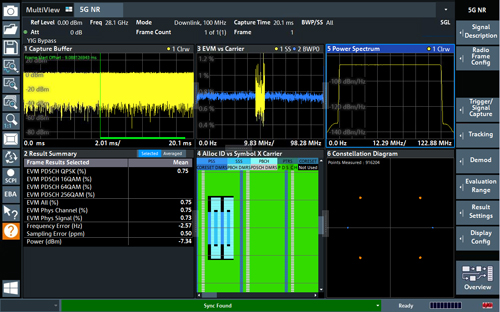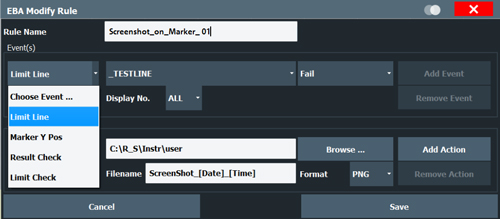
With the advance of 5G NR technology in R&D and production, engineers need to analyze wireless communication signals with test solutions supporting 5G bandwidth and RF requirements. Rohde & Schwarz supports these users with a new family of midrange signal and spectrum analyzers: the R&S FSV3000 and the R&S FSVA3000, available with up to 400 MHz analysis bandwidth and up to 44 GHz input frequency, which cover all relevant 5G NR frequency bands. Their common user interface includes new features for fast setup of measurements and capturing rare events.
The R&S FSV3000 is designed to help users set up complex measurements in the easiest and fastest way. With its usability and high measurement speed, it is the right instrument in both the lab and on a production line. It provides up to 200 MHz analysis bandwidth, enough to capture and analyze two 5G NR carriers at once.
The R&S FSVA3000 has up to 400 MHz analysis bandwidth, a high dynamic range and an outstanding phase noise of −120 dBc/Hz, delivering performance which was reserved for high-end instruments until recently. Users can perform more demanding measurements, such as linearizing power amplifiers, capturing short events and characterizing frequency agile signals.
Both the R&S FSV3000 and R&S FSVA3000 can measure error vector magnitude (EVM) values better than 1 percent for a 100 MHz signal at 28 GHz (see Figure 1), making the analyzer family an ideal fit for analyzing 5G NR signals.

Figure 1 Screenshot of a measured 5G NR signal at 28 GHz with EVM below 1 percent.
NEW, INNOVATIVE USER INTERFACE
Troubleshooting rare events or setting up complex measurements is easy with both the R&S FSV3000 and R&S FSVA3000 spectrum analyzers. An event-based graphical user interface makes it easy to trigger on rare events (see Figure 2). The user only has to select an event, like a limit line failure, from a drop-down menu and add a corresponding action, like a screenshot or saving I/Q data. Whenever the event occurs, the corresponding action is performed, and the event is recorded for later in-depth analysis.

Figure 2 To help with troubleshooting, the event-based action feature enables users to define events that trigger actions like screenshots or recording data in a log.
A one-button measurement feature shortens the setup of the instrument. At the press of a button, the most important parameters like center frequency, span or amplitude reference are automatically set based on the applied signal. In case of a pulsed signal, the gate sweep parameters are also set. For standard conformance measurements on communication signals, like adjacent channel leakage ratio (ACLR) or spectrum emission mask (SEM), the one-button measurement feature selects the corresponding standard parameter table.
When setting up complex measurement plans on an automated production line, external PCs take over the control of measurement instruments via standard commands for programmable instruments (SCPI) programs. The embedded SCPI recorder in the new analyzers makes the programming of such executable control scripts much faster and easier. All manual user input is translated into SCPI commands, which can be exported as plain SCPI or in the syntax of common programming languages or tools such as C++, Python or MATLAB.
With many RF measurements, an additional signal generator is required. The smart signal generator control of the new analyzer family goes far beyond what a classic generator control can do: with the coupling manager, users can control the generator with the analyzer. Changing frequency or level on the analyzer directly controls the generator. The analyzer can even display the user interface of the generator, so the user can operate the complete setup from only one screen. The SCPI recording function of the analyzer and the generator can also be coupled.
HIGH SPEED ANALYSIS
Rohde & Schwarz designed the R&S FSV3000 and the R&S FSVA3000 for high speed performance in automated test systems. They perform spectral measurements, signal demodulation and switching between measurement modes in the shortest time, enabled by fast synthesizer technology. FFT-based ACLR and SEM measurements are faster than swept spectrum measurements, while showing the same dynamic range. The analyzers’ signal analysis options include most modern communication standards like 5G NR, LTE and IEEE 802.11ac and 11ax wireless LAN. Engineers can use them for general-purpose measurements like noise figure, gain, phase noise and vector signal demodulation.
In classic production systems where the analysis takes place on the instrument, an enhanced computer power option provides a faster CPU to accelerate digital signal demodulation. In cloud-based test systems, the signal analysis is done on external CPUs and requires the transfer of huge amounts of I/Q data. The new Rohde & Schwarz analyzer family perfectly interacts with cloud-based processing. The optional 10 Gbps LAN interface enables I/Q data transfer toward the network side at high sample rates, which is required for wideband signal analysis such as 5G.
The R&S FSV3000 and R&S FSVA3000 will be available from Rohde & Schwarz in March 2019.
Rohde & Schwarz
Munich, Germany
www.rohde-schwarz.com/fsv3000
